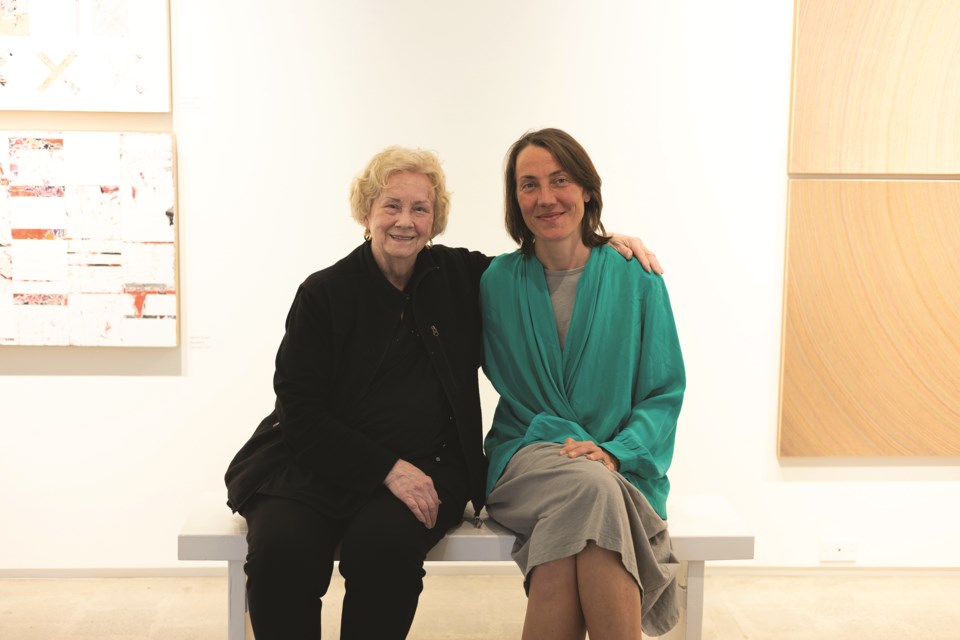Two artists whose works transform prosaic leavings into transcendent topographies opened complementary exhibitions during a reception held at the Gibsons Public Art Gallery on April 5.
In her Gibsons debut, Burnaby-based artist and educator Dorothy Doherty inaugurated Surfaces. The painted panels of its images evoke an archeological dig: Doherty strips away layers of pigment to reveal two-dimensional artifacts underneath. Torn city maps, antique computer printouts, and other paper ephemera of urban life fade into view, shaped and stained by their overcoats.
Meanwhile, in Sunshine Coast artist Carolina Franzen’s Man Made Cloud, Franzen sustains a metamorphic trajectory launched at her first solo show two years ago: repurposing packaging paper from the news distribution industry as substrate for delicate freehand lines. The stacks of coloured striations, seen at a distance, coalesce into undulating landscapes.
“I think we have a similar purpose in mind,” observed Doherty, whose retirement as an art specialist in the public school system was followed by further studies at Capilano University. As a lifelong mixed-media artist, she paints from an East Vancouver studio and shapes ceramics at an arts complex overlooking Burnaby’s Deer Lake. “In terms of why we do our art, we’re both involved with climate change and the environment. Most of my work is driven by an interest in preserving the best of our nature.”
Doherty also works with botanical materials. A collection of small panels provide a glimpse of her latest project: studies of plant material, pressure, heat and time. After gathering distinctive flora, she compresses the biomass between two surfaces then dips it into boiling water sometimes infused with dye. The result — organic minerals transferred to paper — appears as seductively coloured impressions whose primal contours might as well have been traced by contemporaries of Lascaux cave artists.
“I’m always looking to find out what’s beneath,” she added, “revealing what’s below the surface. I think that applies to our human interactions as well: we can dismiss people if they don’t [immediately] fit our paradigm. But then we need to sit down a little bit, and learn a little bit more.” Her manipulation of maps and data reflects the human drive to forge a route through conflicting forces: “Isn’t wayfinding what art’s all about?” Doherty said.
The minute filaments of Franzen’s works also trace singular and independent paths before coalescing into the series’s titular clouds. “Drawing these lines made me gesturally think about reintroducing the tree into the paper, reversing the process [of manufacture],” she said. Her drawings are influenced by her academic background in literary theory; she draws together experiences that are both industrial and natural.
Clouds can manifest as dreamy and miasmic. In her depiction of Texada Island, she reflected on an experience of observing the sun through the haze generated by wildfires. The island gradually came into view, wispy and indefinite in the murk. “It just shadowed the sun slightly, and I felt it was appropriate to document the wildfire like that,” she said. “Clouds are obviously beautiful, but the industrial world, too, is putting out clouds.”
The contrast in scale between Franen’s painstaking ligatures and their resulting macrocosms is intended to prompt reflection on the imperceptible processes that make up the world in its dizzying complexity.
Over four adjoining panels, she pencilled the concentric rings of a mammoth tree trunk. Its heart is tantalizingly off-centre; she resisted the urge to create a geometrically-explicit gyre by heeding nature’s dictate. “Everyone wants the feeling of a tunnel that you walk into,” she said, “but I realized, no: that doesn’t actually work for me. A tree is not like that.”
Both shows continue until month-end. Franzen will deliver an artist talk at the gallery on April 12 from 2 to 3 p.m. Doherty returns to the gallery to share insights at 2 p.m. on April 27.



